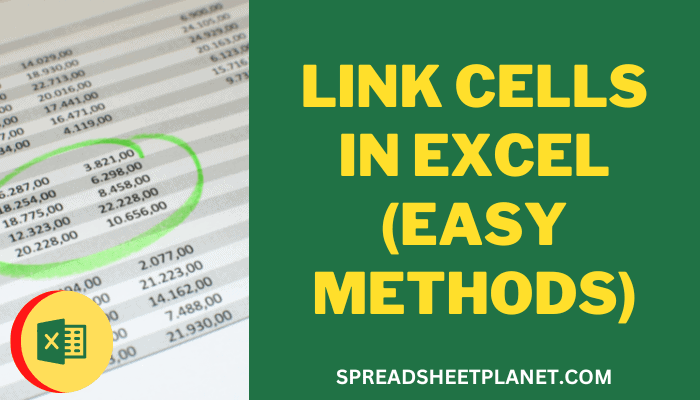5 Ways to Link Excel Cells to Different Sheets Easily

Have you ever needed to combine data from multiple sheets within the same Excel workbook? Managing intricate datasets across various sheets can be daunting, but fortunately, Excel offers intuitive methods to streamline this process. In this comprehensive guide, we'll explore five practical techniques to link Excel cells to different sheets efficiently. This tutorial will empower you to manage your data with greater ease and efficiency, ensuring your workflows are more seamless and productive.
Method 1: Using Cell References

The most straightforward method to link cells across sheets is by using cell references. Here’s how you can do it:
- Select the cell where you want to place the linked data.
- Start by typing = to initiate a formula.
- Click on the sheet tab you wish to link from. The name of the sheet and the formula bar will change to reflect this action.
- Click on the cell in the source sheet whose data you want to reference.
- Press Enter. The formula bar will now show the reference, for example, =Sheet2!B2.
📝 Note: When the source sheet or cell is modified, the linked cell updates automatically, ensuring consistency across your data.
Method 2: Named Ranges

Named Ranges provide a user-friendly way to reference data:
- Go to the sheet containing the source data.
- Select the cells or range you want to name.
- Go to the Name Box (next to the formula bar), type in your preferred name, and hit Enter.
- When you need to link to this named range from another sheet, simply type =NamedRange where NamedRange is the name you assigned.
Named ranges also facilitate easier understanding of formulas across your workbook, which is especially useful in complex spreadsheets.
| Pros | Cons |
|---|---|
| Easily identifiable and manageable | Requires initial setup |
| Improves formula readability | Can clutter the Name Manager if not organized properly |

💡 Note: Named Ranges can be managed or viewed through the Name Manager in the Formulas tab, where you can delete, edit, or add more named ranges.
Method 3: Using 3D References

3D References are particularly useful when you need to link data across similar ranges in multiple sheets:
- Select the cell where you want the linked data to appear.
- Start with an equal sign = in the formula bar.
- Press and hold Shift, then click the first and last tabs in your sequence of sheets. This selects multiple sheets.
- Select the cell or range you want to link, for example, A1:A10.
- The formula should appear like this: =SUM(Sheet1:Sheet3!A1:A10), where you can replace SUM with any aggregate function.
This method is ideal for summarizing data from multiple sheets, providing a powerful tool for complex spreadsheets.
🗒️ Note: The sheets must be in the same order for 3D References to work correctly. Any sheet renaming, moving, or deletion will impact these formulas.
Method 4: Linking Through Named Formulas

Creating Named Formulas in Excel not only streamlines your formulas but also ensures better readability:
- Navigate to the Formulas tab, click Define Name.
- Name your formula, for example, TotalSales.
- In the “Refers to” field, enter the formula, e.g., =Sheet2!B2 + Sheet3!B2.
- When you need this formula elsewhere, simply type =TotalSales instead of the entire formula.
Linking through Named Formulas makes your workbook more modular, which is beneficial for maintaining and scaling your spreadsheets.
Method 5: Hyperlinks for Navigation

If you’re looking to quickly navigate between sheets rather than linking data, consider using hyperlinks:
- Select the cell where you want to insert the hyperlink.
- Go to the Insert tab, then click Hyperlink.
- Choose Place in This Document from the options.
- Select the desired sheet and cell to link to.
- Customize the hyperlink text to make it clear where the link will take you, e.g., “Go to Financial Data.”
Hyperlinks offer a navigation solution, enhancing usability by providing a quick way to jump between sheets.
🚚 Note: While hyperlinks don’t automatically update like cell references, they can be combined with other linking methods for more dynamic navigation and data linkage.
In this guide, we've explored five distinct methods for linking Excel cells across different sheets. These techniques range from simple cell references to more advanced strategies like named formulas and 3D references. Each method provides a unique approach to data management, allowing you to choose or combine techniques based on your specific workflow requirements. By mastering these methods, you'll be better equipped to manage, analyze, and present data in Excel with efficiency and precision.
Can Excel handle large datasets for linking across sheets?

+
Yes, Excel can manage large datasets effectively, but performance can be impacted as the dataset grows. For very large datasets, consider using data management tools like Power Query or linking to external databases.
What happens if I delete a sheet with linked cells?

+
Deleting a sheet with linked cells will result in errors in the formulas that reference it. You must either update the formulas to point to a different source or remove the links before deleting the sheet.
How do I avoid circular references when linking cells?

+
To avoid circular references, ensure that the cells you’re linking to don’t reference back to the original cell or cause a loop within your formulas. Circular references can lead to calculation errors.



